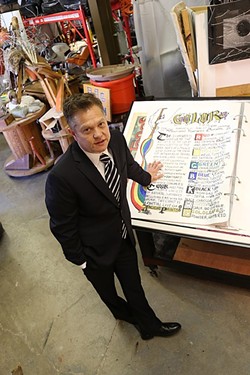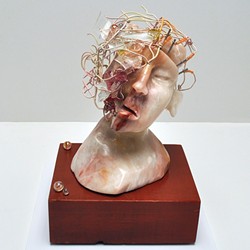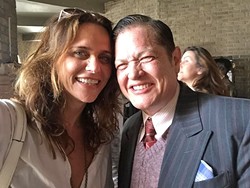[{
"name": "Ad - Medium Rectangle CC01 - 300x250",
"id": "AdMediumRectangleCC01300x250",
"class": "inlineCenter",
"insertPoint": "8",
"component": "2963441",
"requiredCountToDisplay": "12"
},{
"name": "Ad - Medium Rectangle LC01 - 300x250",
"id": "AdMediumRectangleCC01300x250",
"class": "inlineCenter",
"insertPoint": "18",
"component": "2963441",
"requiredCountToDisplay": "22"
},{
"name": "Ad - Medium Rectangle LC09 - 300x250",
"id": "AdMediumRectangleLC09300x250",
"class": "inlineCenter",
"insertPoint": "28",
"component": "3252660",
"requiredCountToDisplay": "32"
}]

Imagine being trapped in a body that just feels wrong, like it’s not yours. That’s how Los Osos artist RawfeyL Gene Burge felt from an early age.
“I was 4 years old, and we had just moved to a new neighborhood, and since this was 1964 Texas, I could just wander the neighborhood. Well, across the street from my house, I ended up in a doghouse with two neighborhood kids my age—a little girl and a little boy—because we were small enough to all fit inside. So we pulled our pants down, and as soon as I saw him, I immediately felt that I was broken. I freaked out because I thought mine [penis] had broken off, and I had to find it. I just lost it. I ran home and was crying to my mom that I’d lost mine, that it had fallen off and we had to find it. What’s crazy is there was a little girl in that doghouse, too, but I completely discounted that other child. I didn’t identify with her at all.”
RawfeyL is transgendered, midway through transitioning from female to male, but it’s been a long time coming. Born and raised in Fort Worth, Texas, the now 55-year-old had a challenging path to become the man he always felt he was inside.
“My parents said, ‘You’re a little girl and there’s nothing you can do about it,’” RawfeyL recalled.
And at the time, that was basically true. Gender reassignment was rare and the LGBT community—especially in Texas—was deep in the closet. Unlike a lot of gay and trans people, RawfeyL was lucky to have a family that supported him, even if the state of Texas didn’t. It had actual laws requiring girls to wear skirts or dresses to school.
“Up until 1975, I had to wear a dress to school, but I’d wear shorts under my dress, and if a school official saw it, I’d be sent home. It felt like an open wound down there. I was afraid my pee would fall out without shorts on.”
Just imagine the girls’ locker room—already a situation fraught with insecurity.
“I was humiliated. I was a top athlete and loved sports, but those moments in the dressing room were horrible.”
And to add insult to injury, RawfeyL, then known as Debra, had enormous boobs.
“My dad always treated me like a boy. My dad wanted a boy and I wanted to be one. He taught me to use tools and taught me how to function in the world like a man.”
Raw’s dad also understood the power of deception.
“He and I rebuilt a Triumph Spitfire my senior year of high school, so that I would have a hot ride in college. When we went to the junkyards to find parts for the car, he said, ‘You’re going to put on a low cut top and some short-shorts, and we’re going to rip these guys off.’ And we did. I went in there with my 16-year-old female body ‘on display’ and we got amazing deals.”
RawfeyL attended the University of Texas, earning a bachelor’s in fine arts in 1982. Through the years, he’s worked in public relations and graphic design, and he eventually opened his first art gallery in what is now a thriving arts district in the Dallas area, though at the time it was a dirt-cheap place to rent a building in an area sandwiched “between two rival gang territories,” Raw explained.
He named and marketed the area as the Bishop Arts District.
“I flyer-ed rich people in the Dallas Area and organized the Bishop Arts annual arts festival, a version of which is still going on.”
According to CBS News, the arts district Raw created “is now one of Dallas’s hottest destinations. It’s home to an eclectic mix of restaurants, music venues, and shops that visitors won’t find in cookie cutter suburban malls.”
“I had big tits and long hair and I started this art district and was basically living in a crack neighborhood. Not many women would do what I did, but I was always a tomboy. I played every sport in school after Title 9 kicked in, and my parents allowed me to be a kind of boy.”
One fond memory of his time in Texas was when Al Gore visited his Bishop Arts gallery in 1996.
“Al Gore touched this,” RawfeyL gleamed, handing me a small sculpture.
Two years later, the artist moved to California, first settling into Avila Beach in 1998.
“My first California studio was in SLO, by College Auto near Sacramento and Broad Streets.”
He relocated the studio to Los Osos nine years ago. One of his goals is to start a salon like Gertrude Stein in Paris in the ’20s, where artists can gather, talk, share their work, and plan how to take over the world—or at least mount a degenerate art show.
“I get to these places where I feel like my goals are bigger than my own art, like I have a bigger vision than just my own artwork and I want to direct other artists, like a conductor of a symphony. I get to where I feel bigger than myself, and I want to move society.”
Now, he’s hoping to change people’s understanding of the trans community.
“That’s what moves me as an artist. It’s not about the sales.”
RawfeyL talks about how some of his art “bites,” and indeed, sharp edges abound, in part because of his materials. He’s a big fan of dumpster diving, using recycled items to create something new. He’s been creating art that merges recycled and high art materials since the early 1990s.
And a lot of his art explores metamorphosis, feminist issues, religious issues, and more—in other words, gender fluidity and the public reaction to it. Let’s face it: Many people just don’t “get” it, mainly because they’ve never experienced it or even know someone who’s trans.
“I’ve been exploring this stuff in my art even before I had a vocabulary to do so, which is why I think there’s a lot of Catholic iconography in my work. When I make things out of this stuff, I’m trying to make each piece [of the assemblage] say something. I ‘write stories’ with physical objects.”
One of his works—a bra sculpture made from barbed wire and broken blue glass titled “A Natural Blue” (2003)—is in the private collection of TV talk show personality Ellen Degeneres, a gift from her staff in 2003.
“I’ve always wanted to be a famous artist all this time, but I was a girl and I had these giant boobs that I hated, and I wanted people to look at my art but not at me.”
Making the transition
It’s not cheap getting gender reconstruction surgery, and it’s not easy convincing insurance companies to pay for it. He began his transition with testosterone therapy in September 2013.
His top surgery was June 6, 2014—“a re-birthday present, removing 18 pounds of flesh in four hours,” he said.
And then this: “Catherine Ryan Hyde paid for my surgery. She paid it forward. She walked it.”
Hyde, the best selling Cambria-based writer known for her novel Pay it Forward, was following Raw’s story on Facebook and decided to help.
“I had known him for several years, and was following his Facebook journey toward being able to afford this surgery,” Hyde explained via email. “I had a kind of ‘aha’ moment. The heart of paying it forward, to me anyway, is that you see someone struggling with a problem that’s overwhelming to them. But it would not be overwhelming to you. It would be fairly easy. It might not be your problem, but you suddenly realize it’s one you could help with easily. I struggled financially for years as an author, so I know how it feels. But I’m not struggling now. I knew I could genuinely spare that money. There was nothing I needed that I would have to do without if I made that gift. And frankly, there was nothing I could buy for myself that would be so utterly life changing. I wanted that piece of money to buy as much happiness as it could. So I told RawfeyL, and it’s true, ‘In the past couple of years all my dreams have come true. Time to see what other people are dreaming.’ And the transformation to happiness and confidence I’ve witnessed is worth it a hundred times over. They say money can’t buy happiness, but it’s not always true. Sometimes it depends on what’s making you unhappy.”
Raw couldn’t be more grateful, and the gift extricated him from a battle with an insurance company.
“She told me she was [financially] set and in a place where she could change someone’s life, and she did, and it was huge for me. It did change my life. I hope to get to the place in my life where I too can pay it forward,” he said.
According to Hyde, Raw is the one who paid it forward: “At the end of 2011, I was struggling to make my basic bills. My camera, which is very important to me, began failing. I couldn’t take money away from the bills to buy a new one. It wouldn’t have been responsible. RawfeyL picked this up and started a FundRazr page for a new camera for me. I hadn’t ever forgotten that. Hard thing to forget. It’s nice to do something for someone that you know for a fact would do the same for you.”
Imagine being freed from that unfamiliar body. Raw found the right doctor in Denise Taylor, who’s currently halfway through a yearlong stint working in an Australian prison.
“When I return, I will go back to my clinic at the Community Health Center where I see people living with HIV/AIDS and also treat transgender people,” Taylor explained via email. “I see kids, teens, and adults who identify as transgender or gender variant. They’re all generally suffering to a lesser or greater degree of gender dysphoria, usually depending on how accepted they feel by the people in their life. It is quite interesting. I follow close to 100 people who are gender variant/transgender and they come from SLO, Ventura, Bakersfield, Mojave, Fresno, Yosemite area, and all places in between. People are desperate for care.
“I have a number of female-to-male patients like RawfeyL,” Taylor continued. “Having ‘top surgery’—a mastectomy with chest reconstruction—has been a key component of his ability to live his life to his true potential. When he had the large pendulous breasts, it was difficult for him to wear the clothes he felt were appropriate and it was impossible for him to be seen as anything but ‘female’ to the outside world. He was fortunate to have a benefactor who was willing to pay for his surgery and thereby significantly increase his quality of life.”
Raw would eventually like to get “bottom surgery,” but it costs in the neighborhood of $80,000. In the meantime, he got a hysterectomy in May 2015, which some doctors had refused to do as part of a gender reconfirmation process.
“The ‘bottom surgery’ is much more involved regarding the external parts for female-to-male (FTM) patients, and most of them will probably never have reconstructive surgery of their genitals,” Taylor explained. “However, having a simple hysterectomy can really make a difference in someone’s mental state. Removal of these female anatomic structures, if desired, can help a FTM’s self image even when no one else can see the difference.”
Even if Raw never has the means to pay for bottom surgery, he’s worlds apart from where he was.
“I consider RawfeyL to be an Obamacare success story,” Taylor said in regards to his hysterectomy. “Prior to having access to basic health insurance coverage (MediCal), Raw was having to pay for his medications out of his meager earnings and in no way could he afford to have surgery. He was having recurrent urinary tract infections and we were treating it with multiple courses of antibiotics. Once we were able to find a surgeon who would perform the hysterectomy, RawfeyL was able to have a gender confirming procedure—getting rid of the female anatomy—while also dealing with the bladder problems that were related to the female anatomy being atrophied from menopause. It wasn’t easy to find a surgeon who would perform this surgery and also accept MediCal as payment. Fortunately, we were able to have Raw see a doctor in the North County who was trans friendly, trans accepting, and willing to perform an ‘elective’ procedure that in actuality can be a significant part of the treatment of gender dysphoria. Most importantly, Raw was able to have great medical care from someone who was willing to help in a meaningful and sensitive manner.”
Raw explained more: “Doctors all over SLO said no, but Denise worked with a gynecologist in Atascadero, Dr. [Larry] Hirsch, who agreed to work with me, in spite of insurance barriers to gender specific treatments for trans patients, who have legally changed their gender via the court system. It’s supposed to be covered in transition surgery, but we couldn’t use gender dysphoria as a reason and get the insurance to cover a surgery normally covered if I had not changed my gender.”
Taylor added: “I think Raw’s story highlights many issues facing transgender people in our community. They face discrimination on multiple fronts—education, social, employment, and medical. Many trans people don’t feel comfortable with themselves (pre transition) or comfortable around others (while transitioning) and may not seek out, or be outright denied, opportunities for education and work. Trans people are often shunned by previous friends and family when they ‘come out’ and may have trouble being accepted by the general community at large. This occurs especially when out in public places and simply wanting to use the restroom facilities or go to a gym. Most outrageously, many trans people face discrimination or indifference and sometimes outright hostility from health care providers. This has an immense ripple effect on a group of people who already feel marginalized and don’t know where else to turn for help if doctors or nurses turn them away. It’s been my honor and privilege to care for this group of people. They place their trust in me and I try to do everything I can to help them realize their true potential. It is why we are all here after all.”
Moving forward
Raw has been lucky throughout the transition process to find advocates willing to stand up for him. More importantly, his family has been very supportive. His biggest difficulty these days is securing employment. Even though he’s been successful in public relations and graphic design, “all those successes are under another name and another gender, and that on an application is a red flag before you ever get to talk to anyone,” he said.
Since his transition started, he hasn’t been able to find work. In 2015, he applied for “more jobs than I am years old” and didn’t get one call back. He eventually wore down a local tailor for a job he says he loved, but she couldn’t hire him for more than a few hours per week. Underemployment is unfortunately a common problem for the transgender community.
“How hard is it to get a job?” Raw asked incredulously. “The only time I got a call back for an interview—in this case the casting call—is when I applied to be a background actor on Transparent. And what a great job to get! It was the best work environment of any job I have ever had.”
Created by writer-director Jill Soloway and produced by Amazon Studios, the streaming TV series began in 2014 and stars Jeffrey Tambor as Maura Pfefferman, the patriarch of a dysfunctional family who begins to transition to womanhood. RawfeyL appeared in a few episodes—the only work he’s had since the transition but not enough to pay his rent.
“Jill Soloway is very proactive in the trans movement,” Raw explained. “She opens every set day with what I call a gratitude speech, reminding us how lucky we are to work on a show with no budget [limit], no time limit, that we get to make art and change history. She makes sure everyone on set knows they’re valued, that their work is valued, and that we’re all equals. Even if a background actor says they want to try something a little differently or have an idea, she listens and we do another take. I think she’s changing the way Hollywood does things. And her set is very open. If you want to talk to Jeffery Tambor, you probably can. I spent all day working next to a cameraman who said this was the best working environment he’d ever experienced in over 20 years in the industry. Maybe it’s because Amazon has all the money in the world.”
Without a job and only the unpredictable revenue stream from art sales to keep him afloat, Raw has struggled from month to month.
“If it wasn’t for my mom, who’s in a facility and needs the money for her own care, helping me with rent, I’d be homeless,” Raw admits, “even with all the talent I have. I want to be a famous artist so I can change things for my family, my friends, and people I will employ one day.”
Despite the struggles, Raw has never been happier or better adjusted. His maleness is no longer questioned.
“For the first year and a half, everyone was ma’aming me, but then the hormones started kicking in,” he recalled.
Even with testosterone, Raw still has to work hard to morph his once womanly physique into a male body. In fact, his studio has a full gym and he lifts weight regularly. He also worked as a personal trainer in the past.
“The hormones give me the base amount of testosterone of a normal man, but I still have to work at it, like any other 55-year-old guy.”
Every day he works at his art, which often starts with dumpster diving. What do his neighbors think?
“They think it’s weird, but I’m a recycler. I’m recycling my art, my clothes, and my body. I am living my life as my ultimate art form. I love my life.”
For transgendered people, Raw is a success story. One in five transgender people in the U.S. has been discriminated against when seeking a home, and more than one in 10 have been evicted from their homes because of their gender identity. One in five transgender people have experienced homelessness. In fact, a large number of transgender and other LGBT-identified youth are homeless in the U.S.—an estimated 20 to 40 percent of the more than 1.6 million to 2.8 million homeless youth even though they make up just five to 10 percent of the general population.
“Before, I didn’t know what I was fighting, but now I understand I was fighting for civil rights for all, but you need a certain amount of power to get people to listen,” Raw said.
Glen Starkey is a New Times staff writer. Contact him at [email protected].
Latest in News
Readers also liked…
-

Coast Unified teachers upset over new position's salary and qualifications
Oct 20, 2022 -

SLO police identify alleged driver who hit and killed couple
Dec 22, 2022 -

When the levee breaks: Oceano residents, county officials walk a tightrope of regulations to manage Arroyo Grande Creek, which some say led to the levee's failure in January
May 18, 2023














